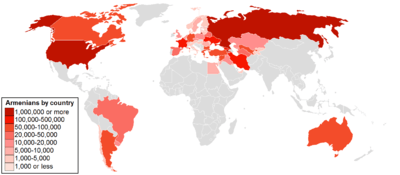Armenians in Bangladesh
| Regions with significant populations | |
|---|---|
| Dhaka | |
| Languages | |
| Armenian, English, Bengali | |
| Religion | |
| Armenian Apostolic | |
| Related ethnic groups | |
| Armenian |
The Armenians in Bangladesh are ethnic Armenians who lived in what is now called Bangladesh. Their numbers have diminished significantly, but there is a notable presence in the country, particularly in Dhaka.
There was a fairly large Armenian colony in Dhaka during the early part of the 18th century, most of whom were engaged in the jute trade. Prominent Armenian jute merchants had their own companies, like Messrs Sarkies & Sons, Messrs David & Co., etc. Gradually, the jute business was monopolised by the more powerful and better-organised British firms. The early Armenian settlers built a small chapel in the midst of their community graveyard. By the end of the 18th century, the Armenian community had grown considerably, and the chapel was found inadequate for the needs of the community, so it was replaced by the Holy Resurrection Church. The church was completed in 1781 and consecrated by Bishop Ephreim.[1] A belfry was added in 1837. In 1910 a parsonage was added and the floor of the church was decorated with marble, and electric lights.
The Armenian Apostolic Church of Holy Resurrection of Dhaka still remains today.
Armenian community of Dhaka
The Armenian community of Dhaka played a significant role in Bengali trade and commerce in the 17th and 18th centuries. In the early part of 18th Century, Armenians settled in Dhaka, then one of the commercial centres in Bengal. They initially built a chapel and cemetery at Tejgagon, five miles from Dhaka. The oldest tombstone is “Avetis” an Armenian merchant who died on 15 August 1714. Apart from Dhaka there was a significant Armenian presence in Saidabad (a suburb of the capital Murshidabad), Hoogli, Kolkata, Chinsura, Patna and Kasimbazar. A neighborhood in Dhaka, Armanitola, bears their name; there is the Church of the Holy Resurrection and the cemetery established by the community in 1781 standing as major landmarks.[2][3] Their assertive presence, however, began to decline from the beginning of British rule. Michael Joseph Martin (Mikel Housep Martirossian) is reported to have been the last Armenian in Dhaka.[4]
